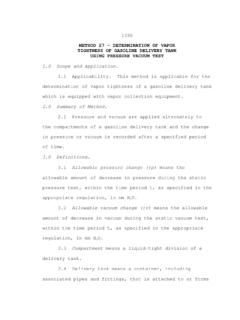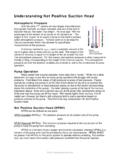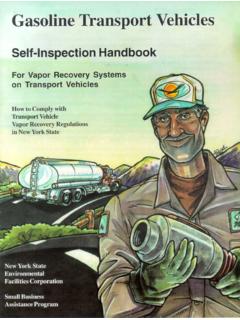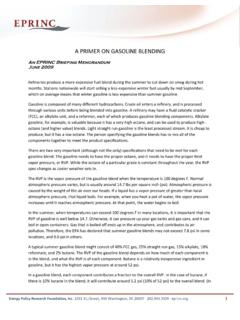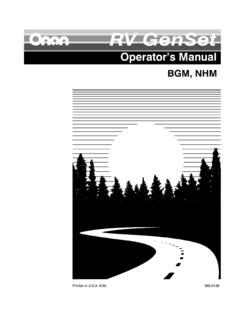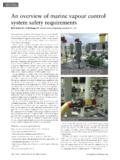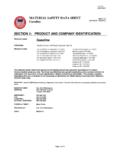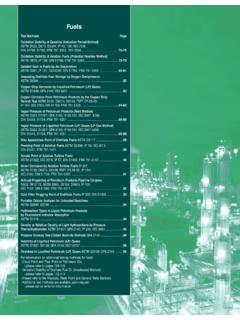Transcription of Gasoline Vapor Pressure Control - CEMDA
1 Gasoline Vapor Pressure & US RVP Control Glenn W. Passavant MWV August 2015 Purpose & Overview Purpose of this presentation is to discuss Gasoline Vapor Pressure , RVP, and the effect on vehicle evaporative emissions Review key terms and concepts Overview of current US program Vehicle evaporative emission effects Gasoline /alcohol blends RVP and Emission Effects for Mexican Vehicles 2 Key Terms and Concepts Evaporation: - the change of phase from a liquid to a gas; the rate is strongly dependent on temperature Volatility property of a liquid fuel which defines its evaporative characteristics. Volatile fuel is any fuel that is a gas at atmospheric Pressure ; Gasoline , methanol, ethanol, natural gas, and LPG are volatile fuels. Volatile liquid fuel - a fuel that is liquid at atmospheric Pressure and has an RVP higher than psi - Gasoline , ethanol, and methanol are good examples.
2 Diesel fuel is not considered volatile. True Vapor Pressure (TVP) - is a common measure of the volatility. It is the absolute Pressure of a Vapor in thermodynamic equilibrium with its condensed phases in a closed container. Vapor Pressure increases exponentially as temperature increases. It depends on no other parameter. Compounds with high TVPs have low boiling points. Partial Pressure the Vapor Pressure of any given component in a mixture; the TVP is the sum of the partial pressures of all gases in the mixture. Boiling point: the temperature where the TVP equals the external Pressure . Varies with atmospheric Pressure , elevation, or fuel tank Pressure . The boiling point of a mixture such as Gasoline is when the sum of the partial pressures equals external Pressure . Mixtures such as Gasoline often are referred to as having a boiling range not just a single boiling point.
3 3 Reid Vapor Pressure Reid Vapor Pressure (RVP) is the absolute Vapor Pressure of a volatile fuel at (100 F ) as evaluated using ASTM method D323A. For Gasoline /oxygenate blends use ASTM D4953. The term dry Vapor Pressure equivalent (DVPE) (ASTM D5191) is often used interchangeably. DVPE and RVP values for a fuel sample are close but not identical. TVP and RVP are numerically very similar at 100 F. However, at temperatures less than 100 F RVP>TVP and at temperatures greater than 100 F TVP>RVP. ISO 3007-1999 is the RVP test procedure used in Europe. RVP is the most commonly used metric in discussing automotive Gasoline Vapor Pressure and its regulation. 4 Gasoline and Gasoline Vapor Gasoline is a mixture of hydrocarbon substances of various formulas and widely-varying formula weights. Certain of its properties are subject to specification limits, but the composition is not.
4 No two batches of Gasoline are ever exactly alike. Not being a pure substance, Gasoline has no single boiling point. Instead, the lighter fractions start boiling out at 90-100 F, with more and more evaporated as the liquid temperature increases, until the final heaviest fractions evaporate in the 300-400 F range. This behavior creates what is sometimes called a distillation curve . Although the molecular formula varies, it is close to with a formula weight of 100 to 105 g/mole. Vapor Pressure or RVP is a critical characteristic of Gasoline High RVP compounds are needed for vehicle starting and warm-up for spark-ignition engines. RVP is controlled to reduce Vapor lock concerns for fuel systems where they still exist. Most of the RVP is provided by isomers of propane, butane, and pentane .. butane is blended in various amounts to adjust RVP. However, most of liquid Gasoline itself is comprised of heavier molecular weight compounds such as larger chain alkanes and aromatics.
5 5 Typical Distillation Curves 0 50 100 150 200 250 IBP 5% 10% 15% 20% 30% 40% 50% 60% 70% 80% 90% 95% End Degrees C Amount Distilled (vol %) 62 kPa Gasoline 69 kPa 10%EtOH SAE Paper 852116: Volatility Characteristics of Gasoline -Alcohol and Gasoline -Ether Fuel Blends 6 Example: Gasoline Vapor vs. Liquid ( RVP ~70kPa) 0 10 20 30 40 50 60 70 C3 C4 C5 C6 C7 C8 C9 C10 C11 Percent of Total Carbon Number fuel Vapor SAE Paper 880712 : Factors Influencing the Composition and Quantity of Passenger Car Refueling Emissions - Part II 7 Why Control RVP? O3 Reactivity Ozone is formed through photochemical interactions of VOCs and NOx. Many different VOCs are emitted into the atmosphere, each reacting at different rates and with different reaction mechanisms. These differences in effects on ozone formation are referred to as the ozone "reactivity" of the VOCs and are quantified through RAFs.
6 Ozone RAFs have been determined for each VOC. The lighter weight compounds which are dominant in Gasoline Vapor are moderately reactive. However, they represent such a large fraction of the total emission mass, that reducing lighter ends through RVP Control is a major ozone reduction strategy. In this example, C3-C5 compounds represent 65% of ozone forming potential emissions from Gasoline Vapor . * SAE Paper 860086: Composition of Vapor Emitted from a Vehicle Gasoline Tank During Refueling ** 17 CCR 94700 : Maximum Incremental Reactivity Values for Compounds - 2010 mass %mass %CA ARBmass vaporCompoundliquid* Vapor *RAF**% wtd , , , , ,2, ,3, What Is Considered in Setting RVP Specifications? RVP is one of the Gasoline characteristics that is specified in consensus standards (ASTM) and in some cases in government regulations. Covers Vapor Pressure and Vapor lock Key factors are temperature and altitude Limits are established in terms of Vapor -liquid ratio (D5188), Vapor Pressure (D5191), and distillation properties (D86).
7 RVP for a given region varies based on temperature and altitude. Regions are usually some political subdivision such as a state line or latitude/longitude coordinates Incorporate allowance for refiner to retail distribution times Incorporate regulatory limits as well as provisions such as ethanol blend waivers. Vapor Pressure for a given batch of Gasoline is finished by adding the needed amount of butane. n-butane 52 psi RVP Isobutane 71 psi RVP RVP Control reduces upstream and mid-stream Gasoline Vapor emissions (distribution, storage) and vehicle emissions. In the US, the upstream/midstream emissions inventory for VOC is about the same as that for motor vehicle evaporative emissions. 9 Altitude/Elevation Vapor Pressure increases exponentially with temperature. Boiling occurs when the Vapor Pressure equals atmospheric Pressure . Additional consideration needed when setting RVP specifications for high altitude areas.
8 Illustration of altitude effect. Diurnal Emissions: 65 -105 F (9 RVP) City Altitude Pressure g/gal of tank Vapor space Los Angeles 100 ft. psi 4 Denver 5280 ft. psi 6 Mexico City 7350 ft. psi -- Effect would be greater for 10% ethanol blend. 10 US REQUIREMENTS 11 Overview Traditionally, US refiners generally followed ASTM D4814 RVP recommendations. In mid 1980s, there was a gradual upward trend in US RVP which led to increased VOC emissions from the Gasoline transportation and storage system as well as from vehicles. A five year long public policy debate ensued which involved refiners, auto industry, and government. This eventually led to California ARB and EPA volatility regulations for summer RVP (Apr15th-Sept15th). See 40 CFR 80. Ultimately, US Clean Air Act was amended to include not only these volatility provisions, but also: ( /fuels/gasolinefuels/ ) Reformulated Gasoline (RFG) (based on model) CAA mandatory and opt-in [part or all 17 states and DC; about 30% of summer consumption] Mandatory RVP controls in some or part of 40 states (7-9 psi RVP)(~47-62kPa) 1 psi RVP ( kPa) waiver for 9-10% ethanol blends US state may opt-out or enforce more stringent standard.
9 Waiver is not permitted for RFG. It varies, but 55-60% of Gasoline usually gets 1 psi waiver. RVP is controlled from refinery gate to retail. Base Gasoline for alcohol blends needs to have low enough RVP so that blend still meets standard. 12 US ASTM Classifications for RVP and Distillation Temperature 13 US RVP and Discussion of ASTM Texas (Apr-Oct) ASTM TexasJanMayJuneJulyAug DecEast 99 99 14 VEHICLE EVAPORATIVE EMISSIONS 15 Categories of Evaporative Emissions SOURCE ON VEHICLE CAUSE OF Vapor GENERATION DIURNAL Tank vent, AIS Daily temperature cycle REFUELING Filler pipe or tank vent Displacement of Vapor by liquid RUNNING LOSS Tank vent and canister vent Heat from engine, exhaust system, fuel pump, and road surface HOT SOAK Tank vent, AIS Latent fuel, engine, and exhaust system heat PERMEATION Tank shell, hoses Diffusion through plastics 16 RVP has a Significant Effect on Vehicle Evaporative Emissions Estimated Emissions Impact of an 8 kPa Difference in RVP for Vehicles Meeting Current Mexican Evaporative Emission Standards ( g/test hot soak + diurnal)
10 Evaporative Emission Category Emissions at 56 kPa Emissions at 64 kPa % change Diurnal (65-105 F) g/gal of Vapor space 31% SAE 892089 Refueling g/gal of fuel dispensed 13% SAE 2010- 01-1279 Running Loss g/km 60% SAE 931191 Hot Soak g/test (75 F) LDV PFI 6% EPA 420-R-01-026 Permeation No relationship with RVP RVP, ambient temperature, elevation, elements of vehicle fuel and evaporative Control system design, and driving patterns all affect evaporative emission rates. 17 Certification vs. In-use RVP KEY PRECEPT: The US EPA and California ARB view vehicles and fuels as a system in the context of emission Control . Fuel quality impacts emissions and the performance of emission Control systems. RVP and ambient and fuel temperatures are the key predictors of vehicle evaporative and refueling emission rates. It is very important that the RVPs and temperatures specified in the emission test procedures lead to Control systems which perform well in-use even as these temperatures and RVPs vary over the year.


